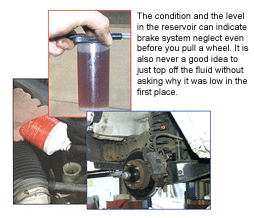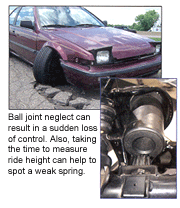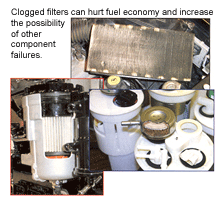It’s that time of year again. Time to start promoting seasonal service checks. So before family hits the road for vacation with gas possibly hitting $3 per gallon, here are some service items that should be checked.
TIRES
Tires obviously play a very important role in safe driving because of their affect on traction, handling and braking. It is unsafe to think that warm weather means that tread depth is not important. Here are some things to look for when inspecting the tires:
TREAD DEPTH – If the tread is worn down to the wear bars, or minimum specifications, the tires need to be replaced.
TOE WEAR – A feathered wear pattern across the tread on the front tires or heavy shoulder wear usually indicates toe misalignment (toe in or out).
CAMBER WEAR shows up on the inside or outside shoulders of the tread. Wear on the inside edge of both tires may be due to negative camber or toe misalignment (too much toe-out). Check for collapsed control arm bushings, a bent strut, mislocated strut tower, or a bent spindle. Wear on the outside shoulder of the tires can be caused by positive camber, toe misalignment (too much toe-in), or hard cornering (driving too fast).
CUPPED WEAR – Badly cupped tires tell you the tires are bouncing as they roll. The underlying cause here may be a wheel balance problem (check for missing weights or excessive runout), or worn shocks or struts.
UNEVEN WEAR – This can occur if the tires are not rotated regularly (every 6,000 miles or so).
INFLATION PRESSURE – Refer to the owner’s manual or vehicle decal for the recommended inflation pressure front and rear. Low tires may indicate a lack of maintenance or porosity leaks in alloy wheels.
BRAKES
Good brakes are absolutely essential for safe driving year-round. Inspecting the following items will help assure your customer’s brakes are up to the task. But, refer to your state’s inspection procedure.
BRAKE PERFORMANCE – If possible, test drive the vehicle and check pedal feel, brake balance and stopping ability. If brakes pull, grab, make noise or the pedal pulsates, further diagnosis is needed.
BRAKE PEDAL – Apply the brakes and start the engine. Does the pedal drop slightly? It should if the vacuum booster is working (note: this does not happen with hydroboost brakes). How does the brake pedal feel? Is it firm? A soft or mushy-feeling pedal usually indicates air in the lines or leaks. A pedal that slowly sinks is a classic symptom of a worn master cylinder. Is the amount of pedal travel normal? A low pedal may indicate worn linings, the need for adjustment, defective or frozen drum brake adjusters or a low fluid level.
PARKING BRAKE – Apply the parking brake. Does the pedal or handle work smoothly? Is it adjusted properly? Does the brake light on the instrument panel come on? No brake warning light may indicate a bad bulb or defective or misadjusted parking brake switch. Put the transmission into gear with the parking brake applied. If it fails to hold the vehicle, it needs adjusting. Now release the parking brake. Failure to release fully means the linkage or cables need attention.
 BRAKE FLUID – A low level may indicate a leak or worn linings. The moisture content of the fluid can be measured with chemical test strips, an electronic fluid tester or a brake fluid refractometer. Recommend a fluid change if you find more than 2 to 3 percent moisture.
BRAKE FLUID – A low level may indicate a leak or worn linings. The moisture content of the fluid can be measured with chemical test strips, an electronic fluid tester or a brake fluid refractometer. Recommend a fluid change if you find more than 2 to 3 percent moisture.
BRAKE LININGS – Remove a front wheel and measure the thickness of the brake pads. If worn down to minimum specifications or if wear indicators are making contact with the rotor, new linings are needed.
ROTORS – Note the condition of the rotors. Deep scratches or grooves indicate a need for resurfacing. Measure runout and parallelism. If out of specs, resurfacing or replacement is needed. Are there discolored spots, heat cracks or warpage? These may also indicate a need for rotor resurfacing or replacement.
CALIPERS – Note the condition of the calipers and caliper mounts, and inspect for fluid leaks. Uneven pad wear usually indicates a caliper is sticking. The cause may be corrosion on the caliper mounting guides or keyway.
DRUMS – Pull a drum and inspect the drum surface, brake shoes, hardware and wheel cylinder. If the shoe linings are at or below minimum specifications, new shoes are needed. If the linings are still above minimum specs, but are getting thin, new shoes should be recommended to extend the life of the brakes. Check wheel cylinders for leaks. If leaking, they must be rebuilt or replaced. New shoes will also be required if the old ones have been contaminated with brake fluid or grease.
BRAKE LINES & HOSES – Check the entire system for leaks, including the master cylinder, proportioning valve, steel brake lines and rubber hoses. Have a helper apply the brakes while you look underneath. Rubber hoses should not expand under pressure. Any hoses that are chaffed, cracked or swell under pressure need to be replaced. Leaks are potentially very dangerous because they may lead to brake failure. Leak repairs should never be postponed.
 SUSPENSION
SUSPENSION
BALL JOINTS – Loaded joints need to have the weight taken off of them before checking. If the joint doesn’t have an internal wear indicator, use a dial indicator to measure joint movement. Always refer to the ball joint specifications for the vehicle.
TIE ROD ENDS – No visible free play allowed. Worn tie rod ends can cause rapid toe wear and steering instability.
INNER TIE ROD SOCKETS – On rack & pinion steering equipped vehicles, check by pinching the rubber bellows. Feel for any looseness while the steering is rocked back and forth. The presence of fluid in the bellows would indicate internal fluid leaks. On a rack with hard plastic bellows, the inner sockets can be inspected by rocking the steering wheel back and forth while watching the tie rod for looseness, or by loosening the large end of the bellows and sliding it away from the housing for direct visual inspection.
IDLER ARMS & PITMAN ARMS – Check idler arms for wear by applying pressure and checking play with a dial indicator. Looseness here can also affect toe alignment and steering stability.
STEERING GEAR – Rock the steering wheel back and forth to check for wear and excessive play. On racks, check the rack mounts, too.
CONTROL ARM BUSHINGS – Worn, collapsed or damaged bushings can affect camber and caster alignment. Don’t forget to check the rear control arms, too.
SHOCKS & STRUTS – Check for leaks, indications of bottoming or other damage. The old “bounce test” is still a valid procedure for finding worn dampers. But a test drive will tell you more.
RIDE HEIGHT – Ride height should be checked front and rear at the specified locations, and compared side-to-side. If below the minimum specs or if off by more than half an inch side-to-side, the springs may need to be replaced.
EXHAUST SYSTEM
EXHAUST MANIFOLD(S) – Is there any detectable exhaust noise when the engine is running? Are there any indications of leakage past the exhaust manifold gaskets (discolored streaks)? Are there any cracks in the exhaust manifold(s)? Are the manifold bolts tight?
PIPE CONNECTIONS – Leaks where the head pipe mates with the exhaust manifold are very common due to engine vibration and rocking (especially in FWD cars).
Oil Filters – Although they are the most often replaced part on a vehicle, there are times when some oil filters can be a pain to replace. The oil filter does not remove moisture, acids or sludge, which is why oil must be changed at the same time the oil is changed. There is little sense in running old, dirty oil through a fresh filter.
 Air Filters – Between 10,000 and 12,000 gallons of air are needed for today’s cars and trucks to efficiently burn one gallon of gasoline. Dirt equivalent to the size of two aspirin tablets within that air will cause the same amount of wear as 75,000 miles of normal driving.
Air Filters – Between 10,000 and 12,000 gallons of air are needed for today’s cars and trucks to efficiently burn one gallon of gasoline. Dirt equivalent to the size of two aspirin tablets within that air will cause the same amount of wear as 75,000 miles of normal driving.
Cabin Air Filters – Modern Cabin Air Filters (CAF), also known as passenger compartment filters, pollen filters or dust filters, have been installed in European vehicles since the mid 1980s. Today, several U.S. manufacturers offer the CAF as standard or optional equipment on various models, and it is estimated, that 85 percent of all automobiles and light trucks produced in the U.S. by the year 2006 will be equipped with a CAF.
A CAF should be changed on a regular basis according to the vehicle manufacturers’ recommendations. If a cabin filter is not changed regularly the efficiency of the fresh air intake system will be diminished.












